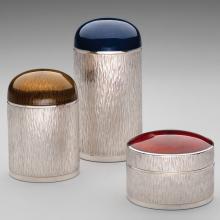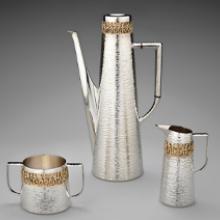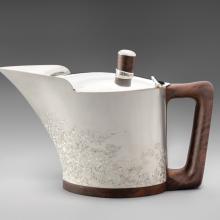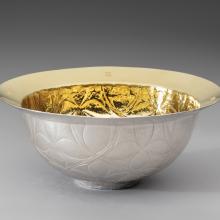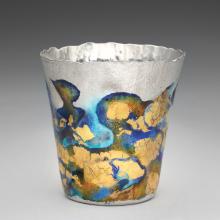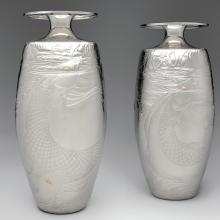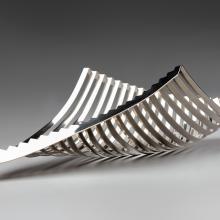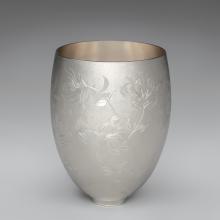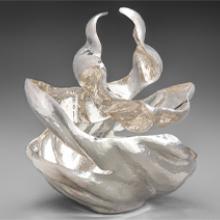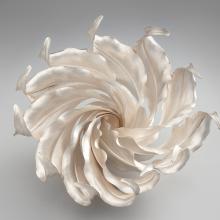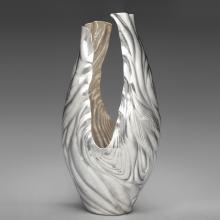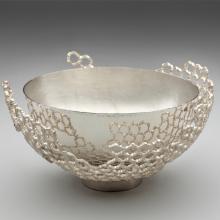International Terminal












|
Cigar cannister 1974 |
Cigar cannister 1972 |
Round box 1976 |
What I am trying to do, and what four or five others in my field are trying to do, is to recreate an international image of English silver in modern terms...what we want to do is to bring the whole craft up-to-date with all the skill in the making that made the earlier silver famous.

Gerald Benney (1930–2008)
Stung by the criticism of an American visitor to his studio that his silver was “all Scandinavian”, an indignant Gerald Benney subsequently broke the idiom with silver designed to be distinctively English—to be “rugged, solid, and functional,” while exhibiting the superb craftsmanship that made the country’s 18th century silverwork famous.
Much of Benney’s output features a textured finish applied with a technique he accidently discovered while hand-raising the bowl of a cup with a damaged planishing hammer in 1961. Inspired by the results, he filed the hammer’s head to emphasize the pattern. Benney’s “Bark Finish,” as it came to be known, provided a contemporary look and tarnish-repelling quality to his forms. With a desire to introduce color to his work in the late 1960s, Benney brought Norwegian enameller Berger Bergerson to England to help his studio perfect an array of translucent enamels.
Figured coffee service 1975
Stuart Devlin (1931–2018)
London
sterling silver, parcel-gilt
The Pearson Silver Collection
L2018.1801.055.01-.03
I felt that the nature of my craft and the romance of precious metals gave me an opportunity to design pieces that added delight, surprise, intrigue and even amusement to what had become austere and even sterile within the ‘modern’ idiom of design.

Stuart Devlin (1931–2018)
Australian-born Stuart Devlin earned a travel scholarship for London’s Royal College of Art, where he studied silversmithing and industrial design from 1958 to 1960. He was subsequently awarded a Harkness Fellowship to pursue silversmithing and sculpture at New York’s Columbia University. After returning to Australia in 1963, Devlin won the competition to design Australia’s first decimal coinage, which changed his life’s trajectory. While supervising the cutting of the dies at London’s Royal Mint, he discovered that British silver was generally shedding its 1950s Scandinavian influence and developing a style of its own. He returned to London in 1965 and established a studio and workshop using his decimal coinage prize money.
Devlin employed his sculptor’s skills to produce a wide variety of textures with molten metal and filigree applied to his exquisite forms. Devlin’s extraordinary creativity inspired his contemporaries and helped propel designer British silver to its renowned position today.
Clipper teapot 2016
Malcolm Appleby (b. 1946) designed and engraved;
made by Peter Musgrove (b. 1946)
Edinburgh
sterling silver, walnut
The Pearson Silver Collection
L2018.1801.026
Making and creating is part of my daily cycle…The making process is an inspiration in itself. I much prefer natural forms and textures to industrial forms and polished surfaces, frequently distorting the silver using corroded tools. These make subtle textures and informal surfaces over which I can engrave.

Malcolm Appleby (b. 1946)
Malcolm Appleby, an exceptionally gifted draftsman, is renowned for his bold designs and innovative engraving techniques. His work effected a more thorough shift in modern British silver from industrial design to handcrafted studio art. Appleby has long been a proponent of hands-on education through intensive workshops, and has inspired generations of silversmiths to make items that appeal to themselves and their clients, rather than catering to popular trends. A generous collaborator with a personality “larger than life,” Appleby is credited with elevating the stature of independent silver artisans during the 1970s.
To realize the broadest limits of his imagination, Appleby’s work spans a variety of media and he frequently collaborates with specialized woodworkers, enamellists, jewelers, and other silversmiths. For more than forty years, designer and silversmith Peter Musgrove (b. 1946) has hand raised many of the pieces Appleby has designed, including this remarkable teapot with walnut base, handle, and finial.
Thorn bowl 2012
Michael Lloyd (b. 1950)
Edinburgh
Britannia silver, parcel-gilt
The Pearson Silver Collection
L2018.1801.015
Behind the world of the artisan is…that desire to take an inanimate material, and bring it to life in a form or image that will sing out; that desire to pay homage to my surroundings, to my creativity; that thanksgiving to that first bite into the apple of awareness.

Michael Lloyd (b. 1950)
Michael Lloyd’s silver reflects his reverence for nature and the inspiration he finds in the landscape of Scotland’s Galloway region, where he has lived and worked since 1989. While attending Wolverhampton College of Art in the West Midlands, Lloyd was introduced to the work of Arts and Crafts designer William Morris (1834–96). This experience altered his artistic trajectory from industrial production towards studio work.
Lloyd later studied under Robert Gooden (1909-2002) and Gerald Benney (1930–2008) at London’s Royal College of Art, where he refined a number of silversmithing techniques, including chasing—a method that utilizes hammers and chasers to press surface decoration directly into the metal. While referring to his Thorn bowl, Lloyd explained, “The inspiration were thorns but I played with them, making them more abstract and altering the proportions. The fact it was not commissioned gave me an element of freedom.”
Oil Slick tumbler 2016
Malcolm Appleby (b. 1946) design and finish;
raised by Peter Musgrove (b. 1946);
enameled by Jane Short (b. 1954)
Edinburgh
Britannia silver, enamel
The Pearson Silver Collection
L2018.1801.027
I see my work as a continual exploration into the possibilities within the technique of enameling and indulging the wonderful range of colors available to me. In some of the work I am interested in subtle harmonies of color, reflecting observations from nature. At other times the richness and vibrancy of the colors provoke a more personal imagery.

Jane Short (b. 1954)
Jane Short studied jewelry at London’s Central School of Art and Design and was introduced to enameling during her second year of coursework. Short recalls “liking the rich quality of the color and the way the light reflected through it. I fell in love with the technique.” Upon graduation, she studied silversmithing under Gerald Benney (1930–2008) and was encouraged by his introduction of color in his silver a few years earlier. Short’s early work reflects her use of cloisonné, in which the enamels are applied within compartments formed by affixed wires or strips of silver. Her current work frequently employs champlevé (enamel in carved or etched cells) and basse-taille (enamel in an engraved or chased low-relief pattern) to produce painterly images that are modeled on her watercolor designs. Short’s stunning enameling of Malcolm Appleby’s Oil Slick tumbler resulted from the designer’s request for the artist to decorate this challenging surface.
Carp vases 1987
Rod Kelly (b. 1956); Garrard & Co.
London
sterling silver
The Pearson Silver Collection
L2018.1801.088.01-.02
I’ll go anywhere to get a feel for my subject matter, whether it’s a river to study wild brown trout, London Zoo to study leopards, or visiting historic buildings to draw and capture views and details, all of which are then woven into my designs.

Rod Kelly (b. 1956)
Rod Kelly studied drawing at Preston Polytechnic before transitioning to 3D Design courses at Birmingham Polytechnic School of Art and Design. Kelly recalls that he borrowed a set of chasing tools while at the college and came upon the technique by chance, “I liked the lines, controlling the metal and the black and white colors of silver.”
Kelly’s pair of Carp vases, completed in 1987 for Garrard and Company, was the artist’s first major commercial commission. For the source material of his design, Kelly purchased two rainbow trout, froze them into contorted, curved forms, and then rendered a series of sketches. The fish are surrounded by a plant motif based on species of native grasses Kelly collected along Hampshire’s River Itchen in South East England. Kelly’s final illustration and design took a matter of days, while the chasing was accomplished over five weeks at a rate of approximately one square inch each hour.
Centerpiece 1996
Rebecca de Quin (b. 1958)
London
sterling silver
The Pearson Silver Collection
L2018.1801.093
The appearance and working properties of silver make it totally unique. For me, it offers enough potential in terms of creative possibilities to last a lifetime.

Rebecca de Quin (b. 1958)
Rebecca de Quin is drawn to the vast, artistic potential offered by working with silver. As a silversmith and teacher, she is “captivated by the purity and simplicity of silver sheet” and has found inspiration in the two-dimensional works of the cubist painter Amédée Ozenfant (1886–1966), the modernist architect and artist Le Corbusier (1887–1965), and her father, the constructivist sculptor Robert de Quin (1927–2002).
In her work, de Quin wishes to “challenge perceptions of three-dimensional form.” Her innovative silversmithing techniques that combine cutting, scoring, and folding, are demonstrated in her centerpiece, which provides remarkably different impressions from all perspectives.
Honeysuckle vase 2013
Angus McFadyen (b. 1962)
Edinburgh
Britannia silver
The Worshipful Company of Goldsmiths
L2018.1801.105
I believe those of us who make things do so because we love to make, possibly even have to make, and that a maker’s craftsmanship adds something to a piece to which others respond or relate.

Angus McFadyen (b. 1962)
Trained as a jeweler, Angus McFadyen taught himself to engrave through trial and error, carefully translating designs from his sketches onto silver forms. McFadyen explains, “the appeal of monotone is very strong to me,” and he finds that “an artist’s drawing is of much greater interest to me than their painting…low-relief carving is really another way of drawing.”
The motif for McFadyen’s Honeysuckle vase is inspired by a wallpaper pattern by British Arts and Crafts designer Lewis Foreman Day (1845–1910). Flowers engraved in low relief are set against a background pattern of slightly elongated dots cut at right angles to one another, which allows light to reflect from different decorative elements with each turn and from every angle.
Flamingo vase 2004
Ndidi Ekubia (b. 1973)
London
sterling silver
The Pearson Silver Collection
L2018.1801.109
I am excited by the sensual and rich forms that can be created by the rhythmic process of making and believe my nature is reflected through my work. It is delightful to be absorbed in every stage, from design to the finished piece.

Ndidi Ekubia (b. 1973)
Ndidi Ekubia is a graduate of London’s Royal College of Art. She employs traditional silversmithing techniques to push sheet silver to its working limits in her Manchester studio. Of Nigerian descent, Ekubia cites inspiration from her African heritage to create flowing, sculptural, and highly expressive forms that range from small, domestic items to stunning centerpieces. The form of Ekubia’s Flamingo vase, hand-raised from a single sheet, appears liquid, as if the silver is flowing upward from the eye of a cyclone
Spiritus centerpiece 2010
Theresa Nguyen (b. 1985)
London
Britannia silver
The Worshipful Company of Goldsmiths
L2018.1801.113
My desire is that a finished piece should feel like a beautifully composed piece of music, able to be spiritually uplifting, emotionally stirring, inspiring and beautiful.

Theresa Nguyen (b. 1985)
Theresa Nguyen is designer-silversmith who is fascinated by the process of transforming an ordinary sheet of silver into a lifelike, sculptural form. Nguyen, a graduate of the Birmingham City School of Jewellery and the post-graduate workshop at Bishopsland Educational Trust, designs and creates nature-inspired silver at her studio in Birmingham. In 2011, Nguyen created her Spiritus centerpiece for an exhibition at the Goldsmiths’ Company in London. The fold-formed piece explored the artist’s perception of containment. To gather source material, Nguyen traveled to many of England’s most renowned gardens, sketching foliage and observing the manner in which plant life unfolds and reaches towards the sun.
Winding Ways vase 2011
Miriam Hanid (b. 1986)
London
fine silver
The Pearson Silver Collection
L2018.1801.116
I hope to encourage an emotional response and a connection, to evoke a sense of movement, of life force, of energy and to share the joy which I derive from the visual world around me.

Miriam Hanid (b. 1986)
Initially trained as a painter, Miriam Hanid was introduced to silversmithing while studying mixed-media art at the University for the Creative Arts at Farnham in South East England. Hanid takes an artistic, painterly approach to silver, incorporating chasing, engraving, and repoussé to add detail to her sculptural forms. In 2011, the artist hand-raised and chased her Winding Ways vase from a single, rectangular sheet of silver. Her surface decoration is inspired by the momentary pattern of flowing water and its “subtle yet powerful ability to shape the landscape.”
Two Brothers’ bowl 2016
Hamish Dobbie (b. 1991)
Edinburgh
sterling silver
The Pearson Silver Collection
L2018.1801.115a,b
In recent months, I have been moving closer to traditional silversmithing, but I’m still keen to combine this with advanced technology…to bridge the gap between the two different approaches so that they become integrated, with the finished work having a natural feel without any hint of fabrication.

Hamish Dobbie (b. 1991)
Glasgow-based silversmith Hamish Dobbie gains much of his inspiration from the rugged landscape of Western Scotland. With geological features such as the hexagonal formations on the island of Staffa in mind, Dobbie uses advanced techniques that include 3D printing and CAD (Computer Aided Design) software to combine modern aesthetics and traditional silversmithing. Dobbie’s Two Brothers’ bowl comprises a pair of nesting bowls made by the artist in 2014 while in residency at the Glasgow School of Art. The highly polished surface of the spun, inner-bowl reflects an outer mesh basket made from hundreds of joined, silver shapes cast from 3D-printed components. Dobbie was the first recipient of the P & O Makower Trust Award, granted in 2015 to commission a silver vase for the National Museums of Scotland.
